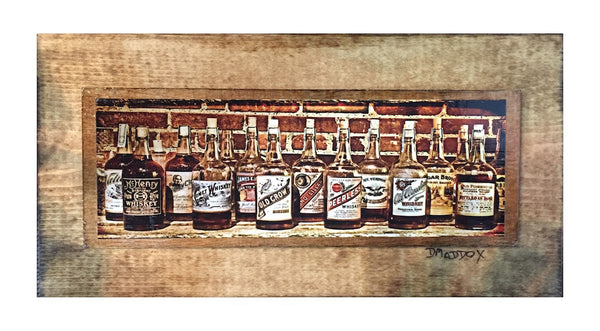Catching the Essence of Scotch Art Via One-of-a-kind Aesthetic Depictions and Styles
The art of bourbon extends past the liquid itself, manifesting through a selection of visual depictions that envelop its storied heritage and workmanship. What stays to be discovered is just how these advancing designs mirror not just the bourbon itself yet also the changing landscape of artistic analysis. Realism Art.
The History of Bourbon Art

As whiskey manufacturing spread, so also did the desire to raise its experience via art. From the detailed inscriptions on very early casks to the fancy tags of modern containers, each aspect mirrors a special artistic vision, serving as a visual story of the scotch's heritage.
In the 18th and 19th centuries, the increase of the industrial revolution better boosted bourbon art, leading to ingenious packaging and advertising that recorded customer attention. Artists and designers began explore aesthetics, imbuing whiskey-related imagery with symbolic meanings that shared concepts of neighborhood, custom, and workmanship.
Today, bourbon art proceeds to develop, mixing traditional approaches with contemporary art forms. Bourbon Art. This ongoing discussion in between the spirit and its visual depiction underscores the enduring bond in between whiskey and society, improving the total experience for lovers worldwide
Iconic Bottle Styles
While many factors add to the appeal of whiskey, renowned container layouts play a crucial duty in forming customer assumption and boosting the overall experience. The visual presentation of scotch bottles is not just a visual factor to consider; it acts as a bridge between the item and the consumer, evoking feelings and establishing expectations.
Distinctive forms, products, and closures can elevate a bourbon brand's identification, making it quickly identifiable on congested shelves. For circumstances, the classic Glenfiddich container, with its sophisticated tapered silhouette, shares a sense of custom and workmanship, while the strong, modern-day design of the Balvenie container mirrors development and sophistication. The use of colored glass or distinct structures can suggest the top quality and personality of the scotch within.
Iconic styles commonly include aspects of cultural heritage, representing the brand name's history and connection to its origins. Brand Names like Jack Daniel's make use of a straightforward, robust layout that resonates with its American bourbon heritage. Ultimately, the effect of container layout extends beyond simple functionality; it envelops the essence of the brand, inviting consumers to indulge and check out in the abundant tapestry of scotch culture.
Label Artwork and Branding
Container designs commonly set the stage for what customers can expect, but tag art work and branding play a similarly considerable role in interacting a scotch's identification. The label serves as the very first factor of call between the consumer and the item, enveloping the significance of the scotch within its visual components.
Reliable label artwork combines typography, color, and images to produce a story that reverberates with the brand's heritage and target market. For example, a label featuring vintage fonts and complex illustrations may stimulate a sense of tradition and workmanship, interesting connoisseurs. In comparison, bold colors and modern style components may draw in a more youthful demographic looking for innovation and exhilaration.


Photography and Visual Storytelling
Catching the essence of whiskey via digital photography and visual storytelling is an art type that elevates the brand name experience. This tool goes beyond plain item depiction, diving into the complex stories that border each bottle. By using compelling imagery, digital photographers can stimulate feelings that reverberate with customers, ultimately creating a deeper link to the whiskey brand.
Aesthetic storytelling in whiskey digital photography often makes use of rich structures, lights, and make-up to highlight the one-of-a-kind attributes of the spirit. The interplay of light and darkness can emphasize the brownish-yellow tones of bourbon, while the selection of history aspects-- such as rustic barrels or elegant glassware-- can enhance the brand name's heritage or way of life associations.
Furthermore, capturing the ceremonial aspects of bourbon usage, from the putting to the tasting, welcomes viewers right into a sensory experience, allowing them to imagine the tastes and scents that await. Each photograph not just showcases the product but likewise tells a story of workmanship, tradition, and the minutes that whiskey can boost - Bourbon Art. Thus, photography comes to be an effective tool in articulating the identification of bourbon brand names, placing them within the broader cultural landscape
Arising Patterns in Whiskey Art
The advancement of bourbon art is increasingly formed by modern fads that reflect broader societal shifts and consumer preferences. This shift not just highlights the relevance of sustainability but also enhances the story bordering scotch manufacturing.
In addition, electronic art has Realism Art surged in appeal, enabling ingenious depictions of scotch. Musicians are leveraging technology to craft immersive experiences, such as enhanced truth installments that engage audiences and supply a much deeper understanding of bourbon's social relevance. This fad also includes social media platforms, where visually striking material gathers focus and cultivates community among enthusiasts.
Moreover, partnerships between bourbon brand names and musicians are becoming extra prevalent. These partnerships produce limited-edition packaging styles and unique art work that celebrate both the craftsmanship of bourbon and the imagination of artists. As whiskey art continues to develop, these arising patterns will definitely form its future, promoting a dynamic intersection of culture, sustainability, and innovation within the whiskey community.
Verdict
In verdict, the art of scotch includes a diverse array of visual representations that reflect its abundant heritage and craftsmanship. From legendary bottle designs and detailed tag art work to compelling digital photography, each element contributes to a broader story that enhances the consumer's experience. As emerging fads, such as electronic art and sustainability, continue to form this creative landscape, the diverse identity of bourbon continues to be a withstanding resource of social connection and expedition.

In conclusion, the art of bourbon includes a diverse range of visual representations that mirror its rich heritage and craftsmanship.